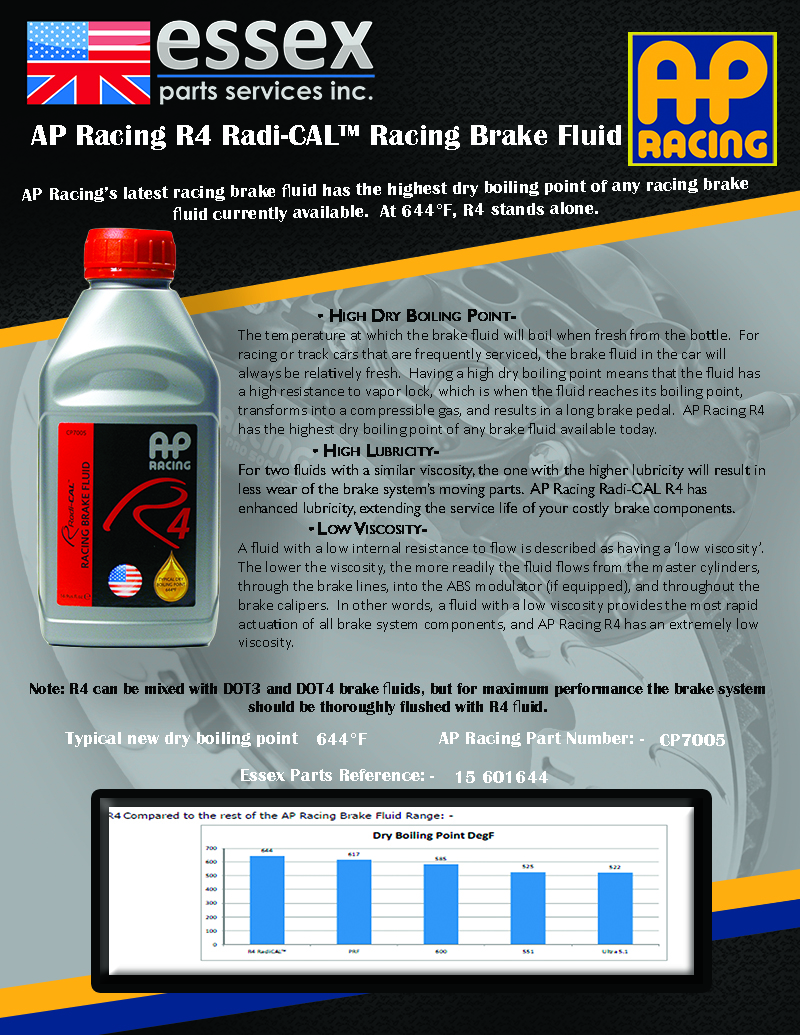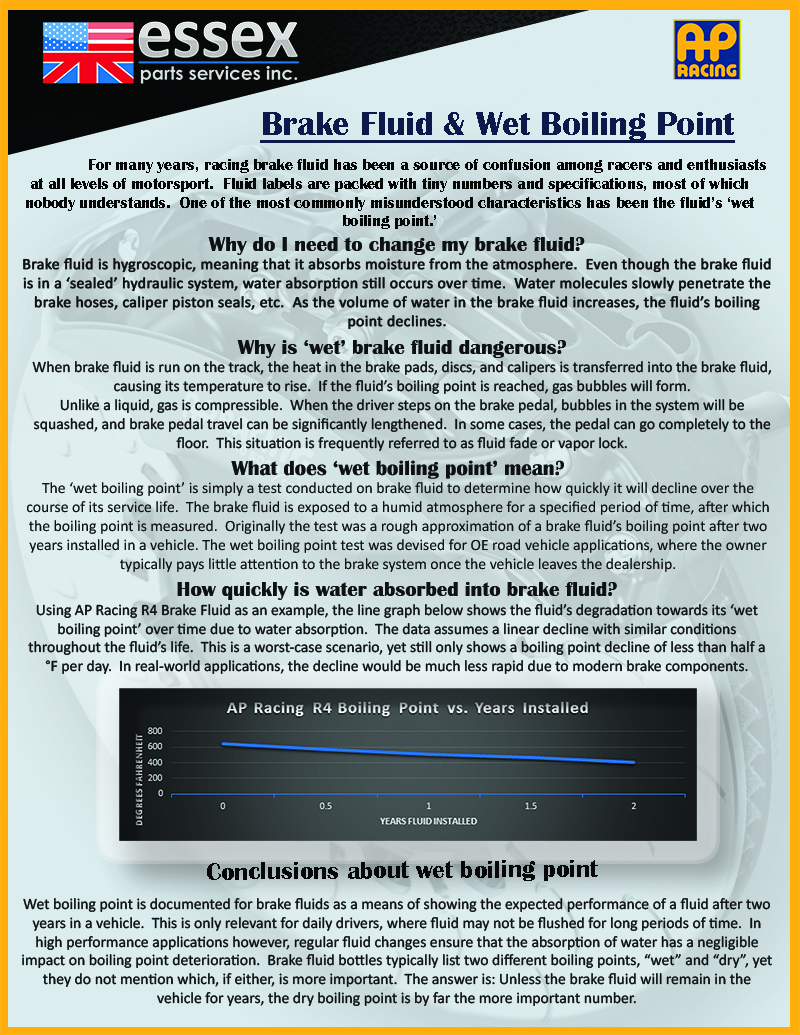Product Guide: How to Choose Racing Brake Fluid
01.08.2020For many years, racing brake fluid has been a source of confusion among racers and enthusiasts at all levels of motorsport. Fluid labels are packed with tiny numbers and specifications, most of which nobody understands. In this article we'll help you understand some of the fundamental characteristics of racing brake fluids, which should help you choose the fluid that most closely meets your needs.
Wet Boiling Point
If you visit the 'racing and competition' section of any automotive forum you'll see thread after thread of grizzled forum veterans waxing poetic on the importance of a brake fluid's wet boiling point. "You need to buy the super expensive stuff in the metal can, or your brakes will be mush by next weekend!" Let's first take a look at what wet boiling point actually means, and why it isn't nearly as important as people make it out to be if you're maintaining your car properly.
Why do I need to change my brake fluid?
Brake fluid is hygroscopic, meaning that it absorbs moisture from the atmosphere. Even though the brake fluid is in a ‘sealed’ hydraulic system, water absorption still occurs over time. Water molecules slowly penetrate the brake hoses, caliper piston seals, etc. As the volume of water in the brake fluid increases, the fluid’s boiling point declines. Again however, the process of water infiltration is extremely slow, particularly with the materials and construction techniques used in modern brake components.
Why is ‘wet’ brake fluid dangerous?
When brake fluid is run on the track, the heat in the brake pads, discs, and calipers is transferred into the brake fluid, causing its temperature to rise. If the fluid’s boiling point is reached, gas bubbles will form. Unlike a liquid, gas is compressible. When the driver steps on the brake pedal, bubbles in the system will be squashed, and brake pedal travel can be significantly lengthened. In some cases, the pedal can go completely to the floor. This situation is frequently referred to as fluid fade or vapor lock. If you've ever had this happen in your car while on track, you realize that it is no fun! When your brake fluid has absorbed a lot of water, its boiling point goes down, making it more prone to fade. Again though, that takes a considerable amount of time!
What does ‘wet boiling point’ actually mean?
The ‘wet boiling point’ is simply a test conducted on brake fluid to determine how quickly it will decline over the course of its service life. The brake fluid is exposed to a humid atmosphere for a specified period of time, after which the boiling point is measured. Originally the test was a rough approximation of a brake fluid’s boiling point after two years installed in a vehicle, at which point the fluid would contain approximately 3.7% water by volume. The wet boiling point test was devised for fluid used in OE road vehicle applications, where the owner typically pays little attention to the brake system once the vehicle leaves the dealership. That minivan parked in your driveway...the one with the goldfish crackers wedged in the rear seats. That's the relevant vehicle with regards to wet boiling point. When you're on the way to Walley World with six kids and all your gear, you don't want to experience brake fade because of a low wet boiling point.
How quickly is water absorbed into brake fluid?
Using AP Racing R4 Brake Fluid as an example, the line graph below shows the fluid’s degradation towards its ‘wet boiling point’ over time due to water absorption using a traditional wet boiling point test. The data assumes a linear decline with similar conditions throughout the fluid’s life. This is an absolute worst-case scenario, yet still only shows a boiling point decline of less than half a °F per day. As noted above, under real-world conditions the decline would be much less rapid due to modern brake components.
Heat in the Brake Fluid
It's not at all uncommon for brake discs on track to see 1300F with caliper temps in the mid 300F range. When you introduce your brake fluid to those types of temperatures, it begins to break down.
Conclusions about wet boiling point
The rate at which the fluid in a modern brake system absorbs water is quite slow, and the wet boiling point is documented for brake fluids as a means of showing the expected performance of a fluid after a simulated two years in the vehicle. Most track day enthusiasts or racers aren't ever going to absorb enough water in their fluid to degrade it to the point of containing 3.7% water by volume. That is a LOT of water in the fluid, and it would have to be in the car under extreme conditions for a very long time to reach that point. 'Wet boiling point' is an outdated method of estimating a fluid's longevity, and it was devised as a yardstick for neglected road cars. Modern brake components largely prevent one from ever reaching that amount of water content in their fluid in any reasonable amount of time, and that is regardless of whether or not the car was tracked. If the fluid does not not degrade to a 3.7% water content, the dry boiling point remains the primary indicator of the abuse the fluid can take before boiling. Brake fluid bottles typically list two different boiling points, “wet” and “dry”, yet they do not mention which, if either, is more important. The answer is: Unless the brake fluid will remain in the vehicle for years, the dry boiling point is by far the more important number when considered it's resistance to boiling on the track.
The Most Relevant Brake Fluid Characteristics for Track/Racing Applications
Now that we understand why wet boiling point isn’t terribly relevant for racing brake fluid applications, let’s look at what actually matters for superior fluid performance.
High Dry Boiling Point- The temperature at which the brake fluid will boil when fresh from the bottle. For racing or track cars that are frequently serviced, the brake fluid in the car should always be relatively fresh. Having a high dry boiling point means that the fluid has a high resistance to vapor lock, which is when the fluid reaches its boiling point, transforms into a compressible gas, and results in a long brake pedal. AP Racing R4 has one of the highest dry boiling points of any brake fluid available today.
Low Viscosity- A fluid with a low internal resistance to flow is described as having a ‘low viscosity’. The lower the viscosity, the more readily the fluid flows from the master cylinders, through the brake lines, into the ABS modulator (if equipped), and throughout the brake calipers. In other words, a fluid with a low viscosity provides the most rapid actuation of all brake system components, and AP Racing R4 has an extremely low viscosity.
High Lubricity- For two fluids with a similar viscosity, the one with the higher lubricity will result in less wear of the brake system’s moving parts. AP Racing Radi-CAL R4 has enhanced lubricity, extending the service life of your costly brake components.
If you'd like to share this information, the essentials are captured in the graphics below. To find fluid for your track car today, please visit our brake fluid page.


Written by Jeff Ritter





Customer Comments:
No comments posted yet
You must be logged in to leave a Comment